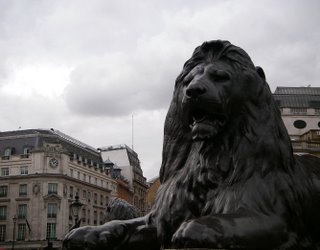
Bath has always been a tourist town. It is situated on top of Britain's only hot spring, which since Celtic times has been thought to provide physical and spiritual benefit to those suffering from various ailments. The Celts associated the springs with their goddess Sulis, to whom healing powers were attributed. When the Romans invaded Britain in 43 A.D. (veni, vidi, vici!), they quickly moved into Bath and began building one of the most magnificent bath complexes in northern Europe. From the Roman conquest through the fourth century A.D., worshippers traveled long distances to partake of the healing powers of the thermal springs and offer sacrifices to the Roman goddess Minerva, who had officially supplanted Sulis as the guardian spirit of the waters. In actuality, Sulis continued to be revered, and depictions of the goddess in Bath are usually referred to as "Sulis Minerva" due to the conflation of the two deities.


The present appearance of Bath is dominated by the Great Bath of the Romans, the fifteenth-century Bath Abbey (noted for the beauty of its fan vaulting and the unusual external facade depicting a dream of its founder in which angels climbed up a ladder to heaven, as well as for being the site of the coronation of the first king of all England, Edgar, in 973) and the elegant Georgian architecture of the residential parts of the city. In the eighteenth century, Bath became one of the most fashionable resort towns in England, again due to the supposed healing powers of its bubbling waters and its proximity to the lovely Somerset countryside. The architect John Wood and his eponymous son created such famous architectural splendors as the Circus and the Royal Crescent, where the wealthy and aristocratic of Georgian England, including resident dandy Beau Nash, whiled away their days in between spa visits. Bath is the setting of the outwardly polite but inwardly vicious social encounters chronicled by Jane Austen, a short-term resident of the city but not a fan, in Northanger Abbey and Persuasion. Sheridan's The Rivals, featuring the unforgettable Mrs. Malaprop, also takes place in Bath; and in Dickens' The Pickwick Papers, the Cockney servant Sam Wellers expresses an aversion to the taste of the spring water, which he describes as having "a very strong flavour o' warm flat irons" - a characterization with which we must say we concur.


We arrived in the morning, and took in the splendours of the abbey and the vaults before venturing out in search of food, which we found at the King William Pub on Thomas Street. This tiny establishment offers unusual, authentic ales and makes an attempt to resurrect truly traditional English food - not the typical pub grub of meat pies and fish and chips, but rather such nearly forgotten delicacies as beer battered sweetbreads with tartare sauce and ham hock terrine on toast. Laura, in honor of her English father who has always proclaimed the culinary virtues of various kinds of innards to the extent of single-handedly boiling and consuming each year's Thanksgiving turkey gizzards, had devilled kidneys on toast; Tam had a steak of pork belly.


Both were delicious. The kidneys were rich, creamy and satisfying, recalling steak and mushrooms. Devilled, a term which the Oxford Companion to Food dates to the eighteenth century, refers to the use of hot spices or condiments in a preparation (thus connecting it with the heat in hell); in this case, it described a mustardy cream sauce with lots of pepper which perfectly complemented the seared kidney slices. Pork belly is a relatively fatty cut of meat which in the United States is most commonly used to make bacon, but is traditionally eaten as a steak in Britain; here, it was glazed with spiced apple jelly and accompanied by beautifully cooked frills of buttery kale and crushed potatoes.
But the adventures of the day were not over. We spent the afternoon exploring the Roman baths, breathing in the healing steam and marveling at the grandeur of the structures, and then went to refresh ourselves in the splendid Pump Room, where Catherine unsuccessfully searches for Mr. Tilney in Northanger Abbey:
Every creature in Bath, except himself, was to be seen in the room at differentUnder the great clock and the swirling Georgian plasterwork, we partook in a another authentically English culinary experience: afternoon tea. The waiter was dressed in a striped vest and spoke with an exaggerately fake posh accent which he dropped as soon as he left us to exchange pleasantries with his fellow workers. We shared a pot of loose-leaf Assam tea, and sampled scones with strawberry jam and clotted cream, raspberry orange cake, a cream-filled praline eclair and a tiny kiwi and almond tart, and felt for poor Catherine Morland and Mrs. Allen as we sipped our tea and observed the scenery.
periods of the fashionable hours; crowds of people were every moment passing in
and out, up the steps and down; people whom nobody cared about, and nobody
wanted to see; and he only was absent. 'What a delightful place Bath is,'said
Mrs. Allen as they sat down near the great clock, after parading the room till
they were tired; 'and how pleasant it would be if we had any acquaintance
here.'


After a leisurely post-tea stroll around the city, taking in the golden architecture and observing the progress of an uber-fancy soiree through the open windows of a splendid house in the Royal Crescent, we felt the need for a fortifying pint before undertaking the train journey back to the crowds and fumes of Paddington Station. The Salamander, offering local Bath Ales like the cool Gem bitter, and appropriately cozy, wood-paneled environs in which to sip them, proved the perfect spot to wind up our English spa town adventure.
 It was a Saturday night at a pub in England, though, and as the cozy space filled up with people and smoke, and the guy standing above Laura's head inadvertently stuck his straw up his nose in his haste to imbibe, we took our leave in an effort to keep our aristocratic vision of Georgian Bath as intact as possible. The savvy traveler has to know when to head home.
It was a Saturday night at a pub in England, though, and as the cozy space filled up with people and smoke, and the guy standing above Laura's head inadvertently stuck his straw up his nose in his haste to imbibe, we took our leave in an effort to keep our aristocratic vision of Georgian Bath as intact as possible. The savvy traveler has to know when to head home. A postscript:
A postscript:
Incidentally, our recent lunch of traditional English food at the Dining Rooms at the National Gallery of Art here in London also deserves mention. With a loaf of dark soda bread, we enjoyed a delicious salad of cured salmon with raw fennel and extra virgin rapeseed oil, a perfectly balanced plate of duck pate with a salad of apple, frizzy endive and shallots, and an exquisite grilled fillet of trout with spelt, lemon and parsley. Our faithful readers may be interested to know that the menu also listed roast haunch of venison with parsnips (!) and glazed chestnuts.






1 comment:
I thought sure there would be a cagy shot of Tam delicately basting Laura in a hot spring.
Uncle Ed
Post a Comment